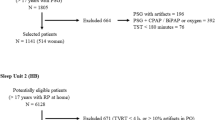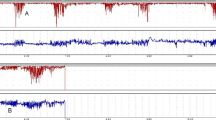Abstract
Purpose
We postulate that using a simple pulse oximetry monitor (POM) to detect the severity of OSA will help clinical staff confirm the need for early treatment. Hence, we compared the POM-derived oxygen desaturation index (ODI) (events/h) with the polysomnography (PSG)-derived apnea–hypopnea index (AHI) (events/h). Our study is intended to validate the SpO2 measurements and related ODI4% and ODI3% (events/h) calculations from POM associated with AHI and ODI from PSG based on 2007 and 2012 criteria.
Methods
All 73 participants (mean age: 51.04 ± 13.14 years old) underwent an overnight PSG test and wore wristwatch POMs (PULSOX 300i) to automatically collect POM oxygen saturation (SpO2) data. Pearson correlation and the Bland and Altman method were used to verify the correlation between POM and PSG.
Results
We found that the POM SpO2 and the PSG2007 and PSG2012 scores were significantly highly correlated (total record time [TRT] and lowest SpO2, R2 = 0.815 and 0.817; ODI4%, R2 = 0.912 and 0.863 and ODI3%, R2 = 0.930 and 0.914). AHI was significantly correlated with ODI4% and ODI3%, but ODI3% was nonsignificantly higher (ODI4%, r = 0.955–0.929; ODI3%, r = 0.965–0.956). Both the ODI3% and the ODI4% were highly diagnostically sensitive and specific. The ODI3% score with the AHI 15 events/h cutoff was nonsignificantly higher (area under the curve [AUC] = 0.99, AHI 15 events/h; AUC = 0.95, AHI 5 events/h).
Conclusion
We conclude that the ODI3% score is a feasible early screening alternative for patients with moderate-to-severe OSA.


Similar content being viewed by others
Abbreviations
- OSA:
-
Obstructive sleep apnea
- POM:
-
Pulse oximetry monitor
- ODI:
-
Oxygen desaturation index
- ODI4% :
-
Oxygen desaturation index drops by 4% (events/h)
- ODI3% :
-
Oxygen desaturation index drops by 3% (events/h)
- AHI:
-
Apnea hypopnea index
- PSG:
-
Polysomnography
- PSG2007 :
-
Scoring criteria of the polysomnography in 2007
- PSG2012 :
-
Scoring criteria of the polysomnography in 2012
- SpO2 :
-
Oxygen saturation (%)
- AUC:
-
The area under receiver operating characteristics (ROC) curve
- ROC:
-
Under the receiver operating characteristic
- AASM:
-
American academy of sleep medicine
- RERAs:
-
Respiratory event-related arousals
- PPG:
-
Photoplethysmography
- BMI:
-
The body weight (in kilograms)/height2 (in meters)
- NC:
-
The neck circumference (in cm)
- PSQI:
-
Pittsburgh sleep quality index
- ESS:
-
Epworth sleepiness scale
- BDI:
-
Beck depression inventory II
- TRT:
-
Total recording time
- DS-5:
-
Development studio 5
- EOG:
-
Electrooculography
- ECG:
-
Electrocardiography
- EMG:
-
Electromyography
- EEG:
-
Electroencephalography
- TST:
-
Total sleep time
- Sens:
-
Sensitivity
- Spec:
-
Specificity
- NPV:
-
Negative predictive value
- PPV:
-
Positive predictive value
References
Young, T., et al. (1993). The occurance of sleep-disordered breathing among middle-aged adults. New England Journal of Medicine,328, 1230–1235.
Mellinger, G. D., Balter, M. B., & Uhlenhuth, E. H. (1985). Insomnia and its treatment: prevalence and correlates. Archives of General Psychiatry,42(3), 225–232.
Young, T., Peppard, P. E., & Gottlieb, D. J. (2002). Epidemiology of obstructive sleep apnea. American Journal of Respiratory and Critical Care Medicine,165, 1217–1239.
Saint Martin, M., et al. (2015). Association of body fat composition and obstructive sleep apnea in the elderly: A longitudinal study. Obesity,23(7), 1511–1516.
Kribbs, N. B., et al. (1993). Objective measurement of patterns of nasal CPAP use by patients with obstructive sleep apnea. American Review of Respiratory Disease,147(4), 887–895.
Kao, L.-T., et al. (2015). Healthcare service utilization by patients with obstructive sleep apnea: A population-based study. PLoS ONE,10(9), e0137459.
Rodenstein, D. (2000). Sleep apnoea syndrome: The health economics point of view. Monaldi Archives for Chest Disease = Archivio Monaldi per le Malattie del Torace,55(5), 404–410.
Deak, M., & Epstein, L. J. (2009). The history of polysomnography. Sleep Medicine Clinics,4(3), 313–321.
Chesson, A. L., Jr., Berry, R. B., & Pack, A. (2003). Practice parameters for the use of portable monitoring devices in the investigation of suspected obstructive sleep apnea in adults. Sleep,26(7), 907–913.
Collop, N. A., et al. (2007). Clinical guidelines for the use of unattended portable monitors in the diagnosis of obstructive sleep apnea in adult patients. Journal of Clinical Sleep Medicine,3(7), 737–747.
Berry, R. B., et al. (2012). Rules for scoring respiratory events in sleep: update of the 2007 AASM manual for the scoring of sleep and associated events. Journal of Clinical Sleep Medicine,8(5), 597–619.
Iber, C., & Iber, C. (2007). The AASM manual for the scoring of sleep and associated events: Rules, terminology and technical specifications (Vol. 1). Westchester, IL: American Academy of Sleep Medicine.
Flemons, W. W. (2002). Clinical practice-obstructive sleep apnea syndrome. The New England Journal of Medicine,347(7), 498–504.
Yamakoshi, S., et al. (2016). Comparison of clinical features and polysomnographic findings between men and women with sleep apnea. Journal of Thoracic Disease,8(1), 145.
Escourrou, P., et al. (2015). The diagnostic method has a strong influence on classification of obstructive sleep apnea. Journal of Sleep Research,24(6), 730–738.
Johns, M. W. (1991). A new method for measuring daytime sleepiness: The Epworth sleepiness scale. Sleep,14(6), 540–545.
Kim, J., et al. (2004). Prevalence of sleep-disordered breathing in middle-aged Korean men and women. American Journal of Respiratory and Critical Care Medicine,170(10), 1108–1113.
Caples, S. M., Gami, A. S., & Somers, V. K. (2005). Obstructive sleep apnea. Annals of Internal Medicine,142(3), 187–197.
Hara, J., & Sakurai, T. (2011). Interaction between sleep mechanisms and orexin neurons. Sleep and Biological Rhythms,9(s1), 38–43.
Sohn, S. I., et al. (2012). The reliability and validity of the Korean version of the pittsburgh sleep quality index. Sleep and Breathing,16(3), 803–812.
Chirakalwasan, N., & Ruxrungtham, K. (2014). The linkage of allergic rhinitis and obstructive sleep apnea. Asian Pacific Journal of Allergy and Immunology,32(4), 276.
Guilleminault, C., et al. (1993). A cause of excessive daytime sleepiness. The upper airway resistance syndrome. Chest Journal,104(3), 781–787.
Vázquez, J.-C., et al. (2000). Automated analysis of digital oximetry in the diagnosis of obstructive sleep apnoea. Thorax,55(4), 302–307.
Jobin, V., Mayer, P., & Bellemare, F. (2007). Predictive value of automated oxygen saturation analysis for the diagnosis and treatment of obstructive sleep apnoea in a home-based setting. Thorax,62(5), 422–427.
Hang, L.-W., et al. (2015). Validation of overnight oximetry to diagnose patients with moderate to severe obstructive sleep apnea. BMC Pulmonary Medicine,15(1), 1.
Amir, O., et al. (2012). Photoplethysmography as a single source for analysis of sleep-disordered breathing in patients with severe cardiovascular disease. Journal of Sleep Research,21(1), 94–100.
Barak-Shinar, D., Amos, Y., & Bogan, R. K. (2013). Sleep disordered breathing analysis in a general population using standard pulse oximeter signals. Sleep and Breathing,17(3), 1109–1115.
Romem, A., et al. (2014). Diagnosis of obstructive sleep apnea using pulse oximeter derived photoplethysmographic signals. Journal of Clinical Sleep Medicine,10(3), 285.
Acknowledgements
The authors thank the staff at the respiratory therapy technologists, Shuang Ho Hospital, Taipei Medical University for assistance. We are grateful to all volunteers for their participation in this study. We also specifically thank the medical staff who participated in the initial study focus on procedure controls and strategy.
Author information
Authors and Affiliations
Corresponding authors
Rights and permissions
About this article
Cite this article
Lin, HC., Su, CL., Ong, JH. et al. Pulse Oximetry Monitor Feasible for Early Screening of Obstructive Sleep Apnea (OSA). J. Med. Biol. Eng. 40, 62–70 (2020). https://doi.org/10.1007/s40846-019-00479-6
Received:
Accepted:
Published:
Issue Date:
DOI: https://doi.org/10.1007/s40846-019-00479-6




